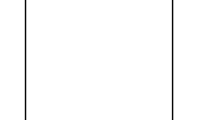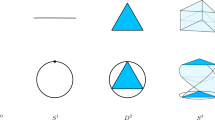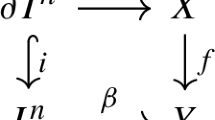Abstract
We study Vietoris–Rips complexes of metric wedge sums and metric gluings. We show that the Vietoris–Rips complex of a wedge sum, equipped with a natural metric, is homotopy equivalent to the wedge sum of the Vietoris–Rips complexes. We also provide generalizations for when two metric spaces are glued together along a common isometric subset. As our main example, we deduce the homotopy type of the Vietoris–Rips complex of two metric graphs glued together along a sufficiently short path (when compared to lengths of certain loops in the input graphs). As a result, we can describe the persistent homology, in all homological dimensions, of the Vietoris–Rips complexes of a wide class of metric graphs.







Similar content being viewed by others
Notes
For every vertex, the lengths of the edges incident to that vertex are bounded away from zero (Bridson and Haefliger 1999, Section 1.9).
Not every persistence module with a real-valued filtration parameter has a corresponding persistence diagram, but isomorphic persistence modules have identical persistence diagrams when they are defined. It follows from Chazal et al. (2013), Proposition 5.1) that if X is a totally bounded metric space, one can define a persistence diagram for \({{\,\mathrm{PH}\,}}_i(\mathrm {VR}(X;r);k)\) and for \({{\,\mathrm{PH}\,}}_i(\mathrm {{\check{C}}ech}(X,X';r);k)\) (where \(X\subseteq X'\)).
One might also call this a pseudosemimetric.
The concatenation of these paths may not be injective, but it is not hard to modify the non-injective loop to obtain an (injective) cycle.
This shortest path is unique since there are no cycles of length at most \(2\alpha \le 3\alpha < \ell \).
We make this assumption for simplicity’s sake, even though it can be relaxed.
The case of \(C_3\), a cyclic graph with three unit-length edges, is instructive. Since \(C_3\) is dismantlable we have that \(\mathrm {VR}(V(C_3);r)\) is contractible for any \(r\ge 1\). But since the metric graph \(C_3\) is isometric to a circle of circumference 3, it follows from Adamaszek and Adams (2017) that \(\mathrm {VR}(C_3;r)\) is not contractible for \(0<r<\frac{3}{2}\).
We have switched the roles of L and K for notational convenience.
References
Aanjaneya, M., Chazal, F., Chen, D., Glisse, M., Guibas, L., Morozov, D.: Metric graph reconstruction from noisy data. Int. J.Comput. Geom. Appl. 22(04), 305–325 (2012)
Adamaszek, M.: Clique complexes and graph powers. Israel J. Math. 196(1), 295–319 (2013)
Adamaszek, M., Adams, H.: The Vietoris–Rips complexes of a circle. Pac. J. Math. 290, 1–40 (2017)
Adamaszek, M., Adams, H., Frick, F., Peterson, C., Previte-Johnson, C.: Nerve complexes of circular arcs. Discrete Comput. Geom. 56(2), 251–273 (2016)
Adamaszek, M., Adams, H., Gasparovic, E., Gommel, M., Purvine, E., Sazdanovic, R., Wang, B., Wang, Y., Ziegelmeier, L.: Vietoris–Rips and Čech complexes of metric gluings. In B. Speckmann and C. D. Tóth, editors, 34th International Symposium on Computational Geometry, volume 99 of Leibniz International Proceedings in Informatics (LIPIcs), pp. 3:1–3:15, Dagstuhl, Germany. Schloss Dagstuhl–Leibniz-Zentrum fuer Informatik (2018)
Adams, H., Heim M., Peterson, C.: Metric thickenings and group actions (2019). arXiv preprint arXiv:1911.00732
Babson, E., Kozlov, D.N.: Complexes of graph homomorphisms. Israel J. Math. 152(1), 285–312 (2006)
Barmak, J.A.: On Quillen’s Theorem A for posets. J. Comb. Theory Ser. A 118(8), 2445–2453 (2011)
Barmak, J.A., Minian, E.G.: Simple homotopy types and finite spaces. Adv. Math. 218, 87–104 (2008)
Biswal, B., Yetkin, F.Z., Haughton, V.M., Hyde, J.S.: Functional connectivity in the motor cortex of resting human brain using echo-planar MRI. Magn. Reson. Med. 34, 537–541 (1995)
Björner, A.: Topological methods. Handb. Comb. 2, 1819–1872 (1995)
Bridson, M.R., Haefliger, A.: Metric Spaces of Non-Positive Curvature. Springer, Berlin (1999)
Burago, D., Burago, Y., Ivanov, S.: A Course in Metric Geometry, vol. 33. American Mathematical Society, Providence (2001)
Carlsson, G.: Topology and data. Bull. Am. Math. Soc. 46(2), 255–308 (2009)
Chachólski, W., Jin, A., Scolamiero, M., Tombari, F.: Homotopical decompositions of simplicial and Vietoris Rips complexes (2020). arXiv preprint arXiv:2002.03409
Chan, J.M., Carlsson, G., Rabadan, R.: Topology of viral evolution. Proc. Natl. Acad. Sci. 110(46), 18566–18571 (2013)
Chazal, F., de Silva, V., Glisse, M., Oudot, S.: The Structure and Stability of Persistence Modules. Springer, Berlin (2016)
Chazal, F., de Silva, V., Oudot, S.: Persistence stability for geometric complexes. Geom. Dedic. 173, 1–22 (2013)
Chazal, F., Cohen-Steiner, D., Guibas, L.J., Mémoli, F., Oudot, S.Y.: Gromov–Hausdorff stable signatures for shapes using persistence. Comput. Graph. Forum 28(5), 1393–1403 (2009)
Dong, F., Koh, K.-M., Teo, K.L.: Chromatic Polynomials and Chromaticity of Graphs. World Scientific, Singapore (2005)
Edelsbrunner, H., Harer, J.L.: Computational Topology: An Introduction. American Mathematical Society, Providence (2010)
Gasparovic, E., Gommel, M., Purvine, E., Sazdanovic, R., Wang, B., Wang, Y., Ziegelmeier, L.: A complete characterization of the one-dimensional intrinsic Čech persistence diagrams for metric graphs. In: Research in Computational Topology (2018)
Hatcher, A.: Algebraic Topology. Cambridge University Press, Cambridge (2002)
Hausmann, J.-C.: On the Vietoris–Rips complexes and a cohomology theory for metric spaces. Ann. Math. Stud. 138, 175–188 (1995)
Kozlov, D.N.: Combinatorial Algebraic Topology, volume 21 of Algorithms and Computation in Mathematics. Springer, Berlin (2008)
Kuchment, P.: Quantum graphs I. Some basic structures. Waves Random Media 14(1), S107–S128 (2004)
Latschev, J.: Vietoris–Rips complexes of metric spaces near a closed Riemannian manifold. Arch. Math. 77(6), 522–528 (2001)
Lesnick, M., Rabadan, R., Rosenbloom, D.I.: Quantifying genetic innovation: mathematical foundations for the topological study of reticulate evolution. SIAM J. Appl. Algebra Geom. 4(1), 141–184 (2020)
Matoušek, J.: LC reductions yield isomorphic simplicial complexes. Contrib. Discrete Math. 3(2), 37–39 (2008)
Oudot, S., Solomon, E.: Barcode embeddings for metric graphs (2017). arXiv preprint arXiv:1712.03630
Quillen, D.D.: Higher algebraic k-theory: I. In: Bass, H. (ed.) Higher K-Theories, pp. 85–147. Springer, Berlin (1973)
Sousbie, T., Pichon, C., Kawahara, H.: The persistent cosmic web and its filamentary structure—II. Illustrations. Mon. Not. R. Astron. Soc. 414(1), 384–403 (2011)
Turner, K.: Rips filtrations for quasimetric spaces and asymmetric functions with stability results. Algebr. Geom. Topol. 19(3), 1135–1170 (2019)
Virk, Ž.: 1-dimensional intrinsic persistence of geodesic spaces. J. Topol. Anal. 12, 1–39 (2018)
Acknowledgements
We are grateful for the Women in Computational Topology (WinCompTop) workshop for initiating our research collaboration. In particular, participant travel support was made possible through the grant NSF-DMS-1619908. This collaborative group was also supported by the American Institute of Mathematics (AIM) Structured Quartet Research Ensembles (SQuaRE) program. EP was supported by the High Performance Data Analytics (HPDA) program at Pacific Northwest National Laboratory. RS is partially supported by the SIMONS Collaboration Grant 318086 and NSF Grant DMS-1854705. BW is partially supported by the NSF Grants DBI-1661375 and IIS-1513616. YW is partially supported by National Science Foundation (NSF) via grants CCF-1526513, CCF-1618247, CCF-1740761, and DMS-1547357. LZ is partially supported by the NSF Grant CDS&E-MSS-1854703.
Author information
Authors and Affiliations
Corresponding author
Ethics declarations
Conflict of interest
On behalf of all authors, the corresponding author states that there is no conflict of interest.
Additional information
Publisher's Note
Springer Nature remains neutral with regard to jurisdictional claims in published maps and institutional affiliations.
Counterexample to Adamaszek et al. (2018, Corollary 9)
Counterexample to Adamaszek et al. (2018, Corollary 9)
We thank Wojciech Chachólski, Alvin Jin, Martina Scolamiero, and Francesca Tombari for the following counterexample to Adamaszek et al. (2018, Corollary 9) in the conference version of this paper. We would also like to mention their forthcoming work on homotopical decompositions of Vietoris–Rips complexes (Chachólski et al. 2020).
As shown in Fig. 8, suppose X consists of 4 points in the shape of a quadrilateral of side lengths 0.5, 0.6, 0.5, and 0.6, and with diagonals of length 1.1. Also, let Y consist of 3 points in the shape of a triangle of side lengths 0.5, 0.5, and 0.6. Their intersection \(A=X\cap Y\) is two points at a distance of 0.6. For \(r=1\) the gluing of the corresponding Vietoris–Rips complexes is homotopy equivalent to a circle since \(\mathrm {VR}(X;r) \simeq S^1\) and \(\mathrm {VR}(Y;r)\) is contractible. However, the Vietoris–Rips complex of the gluing is in fact contractible (a cone with apex the single point in \(Y{\setminus } A\)), and hence not homotopy equivalent to the gluing of the Vietoris–Rips complexes.
A counterexample to Adamaszek et al. (2018, Corollary 9), where metric spaces X, Y, and \(A = X \cap Y\) are denoted in blue, red, and purple, respectively. Distances between each pair of points are indicated on the dashed lines
Rights and permissions
About this article
Cite this article
Adamaszek, M., Adams, H., Gasparovic, E. et al. On homotopy types of Vietoris–Rips complexes of metric gluings. J Appl. and Comput. Topology 4, 425–454 (2020). https://doi.org/10.1007/s41468-020-00054-y
Received:
Accepted:
Published:
Issue Date:
DOI: https://doi.org/10.1007/s41468-020-00054-y





